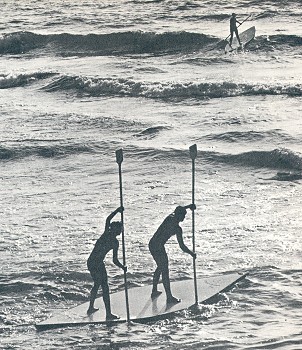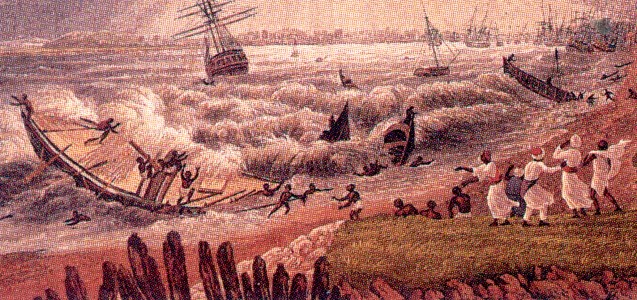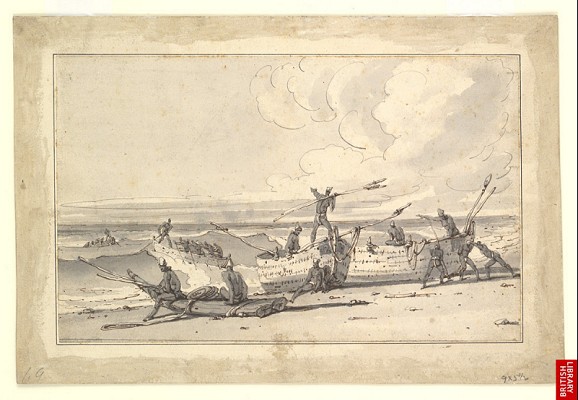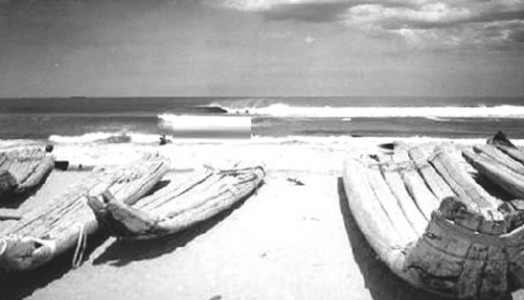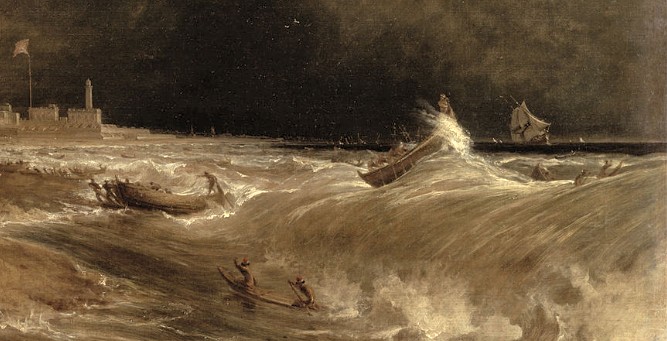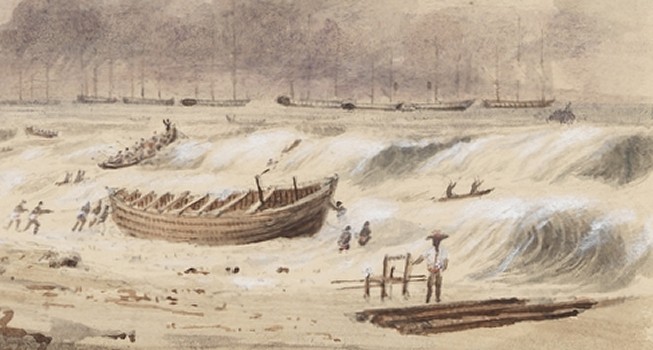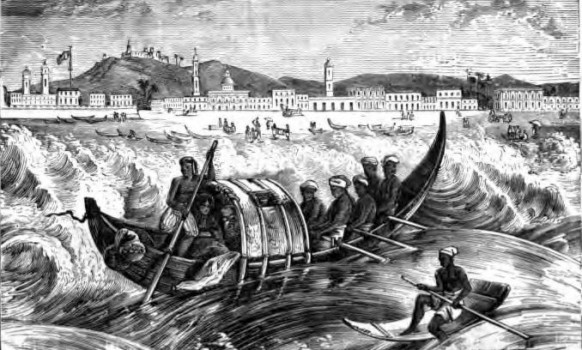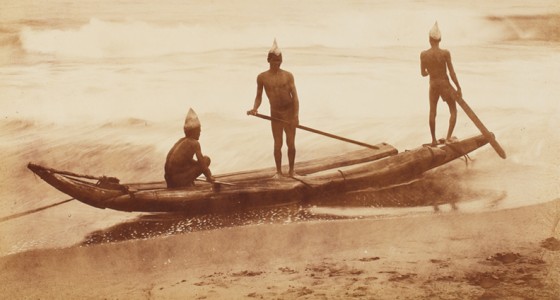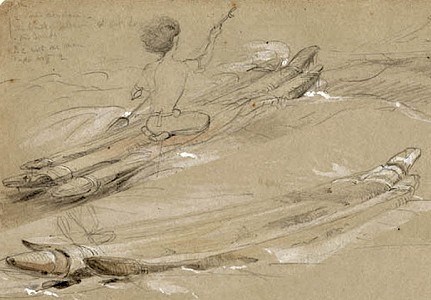 |
surfresearch.com.au
gold :
catamaran and masula at madras, 1800
|
Charles Gold : Catamarans and Masulas, Surf Riding at Madras, 1800.
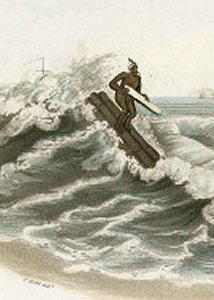
| catamarans | masulas | ANMM |
Overview.
The identification of the illustration, Madrassan men surfing (detail above), by Charles Gold by the curators of the ANMM is a significant contribution to the history of surfing.
Known to be based on his personal observation and dated 1800, it is currently the earliest known image of wave riding; similar images from Hawaii were not published until the 1830s.
To the left, it shows one man riding a three-log catamaran shore ward on a considerable wave.
He rides upright, with his feet parallel, and holding a paddle, while at the illustration's centre, two men are seen on a similar craft in the second line of breakers.
A masula, also known as masoola or masulah, a local surf boat with a crew of six, is heading through the outside breakers, transporting freight for the ships of the East India Company, awaiting off-shore at the Madras Roads.
As a surfriding craft, the catamaran falls somewhere between a surfboard and an outrigger canoe, and the combination of a standing paddling and riding position is a unique.
At the turn of the 20th century, this riding technique was replicated with the development of stand-up paddle-boards (SUPs).
The Catamaran
The catamaran was identified by James Hornell in his seminal Water Transport - Origins and Early Evolution (1946) as an specialised example of log rafts.
Most numerous on the Tamil coast of South India, they were known as kaIfu-mar-am , meaning tied logs, which was anglicized into catamaran.
Writing in 1946, Hornell was already aware of a confusion in meaning, noting a common and deplorable error is to apply this term to an outrigger canoe, a misnomer that causes endless confusion. (1)
Since then meaning of catamaran has had further change, and now commonly means any craft with twin parallel hulls.
In sailing craft, it is typified by the popular Hobie Cat, and the twin-hull has been universally adopted in a wide range of powered vessels. (2)
Two, or more, logs are shaped and bound to a central core to produce a raised and pointed bow and wide stern, the design was adapted to negotiate heavy surf, initially for fishing and later to ferry mail between shore and trading ships in the Madras Roads and provision trading ship,
Catamarans propelled by one or two paddlers (sitting, kneeling or standing)
Working alongside the larger masula, a surf-boat carrying passengers and goods, the catamarans were occasionally employed as rescue craft in the event of an accident.
Charles Gold illustration of a catamaran riding the surf at Madras in 1800 pre-dates similar images from Hawaii by 30 years.
This ancient design was widespread, William Dampier observed similar balsa rafts in Peru in 1684 and Oswald W.B. Brierly illustrated a catamaran off the coast of New Guinea in 1850.
The three part hull design was later replicated with bundles of bound reed and used off the coasts of Peru, Easter Island, and Tasmania.
The raft is one of the most ancient of water craft: "A couple of logs lashed roughly together probably formed the first advance in the evolution of certain types of wooden boats from the wooden block used as a swimming float." (3)
While primitive in design, the fact that it is virtually unsinkable is an outstanding feature for use in the surf zone.
Thomas Bowrey, the English spice trader noted previously, in the 1670s wrote of of the "cattamaran" , on which "they will boldly venture out of sight of the shore, but indeed they Swimme (in generall) as naturaly as Spanyall dogs."
He also sketched a six-log raft with a crew of three, holding short paddles, and, what appear to be, fish traps.(4)
The various accounts and illustrations indicate that the crew was usually from one to three, and the paddlers sit, kneel or stand.
It is unknown if the fish baskets were set as traps offshore, or were used to store the catch onboard.
Adventurer and buccaneer, William Dampier, observing balsa rafts in Peru in 1684, compared them to the craft he had seen ten years earlier in the Bay of Bengal:
"On the Coast of Coromandel in the East-Indies they call them Catamarans.
These are but one Log, or two sometimes of a sort of light Wood, and are made without Sail or Rudder, and so small, that they carry but one Man, whose legs and breech are always in the Water, and he manages his Log with a Paddle, appearing at a distance like a Man sitting on a Fish's back." (5)
A water-colour drawing, by an anonymous artist and dated circa 1787, illustrates a masula boat and a catamaran, with two kneeling paddlers, at sea.
It is inscribed: "A Massula Boat, such as are used at Madras for crossing the Surf as no ship Boat can weather it." (6)
Charles Gold's illustration of 1800 above (7) appears to be the earliest t known image of wave riding; similar images from Hawai'i were not published until the 1830s.(8)
The surfer rides shoreward on a three-log catamaran, with his feet parallel and holding a paddle, on a considerable wave.
A pen and ink wash drawing, Surf boats at Madras (1807) by George Chenney, noted previously, shows a catamaran on the beach in the left foreground, with paddles, fish traps, and crew. (9)
A three-log catamaran, with one forward paddler kneeling and a second standing at the tail, is shown launching through a wave in Catamarans and Masoolah Boat, Madras by John B. East, circa 1834-1836.
The original painting was later reproduced as an engraving under the title Madras, Embarking in 1856.(10)
Little is known of East's life, and while the painting is said to date circa1834, according to one chronology, it is possibly post-1836.
It suggests he was born in England, he first travelled to India c.1830-c.1831, and after a short stay in Australia (1831-c.1835), resided in Madras from about 1836, apparently until his death.(12)
While in Australia, East famously painted a portait of William 'Billy' Blue in 1834, a Jamaican convict ferry master on Sydney harbour of some local fame because of his aphorisms and lively banter.(13)
Basil Hall described the role of the catamaran and its role in the surf conditions off Madras in the early 1800s:
"These primitive little life-preservers, which are a sort of satellites attending upon the great masullah or passage-boat, consist of two or three small logs of light wood fastened together, and capable of supporting several persons.
In general, however, there is but one man upon each, though on many there are two.
Although the professed purpose of these rafts is to pick up the passengers of such boats as may be unfortunate enough to get upset in the surf, new comers from Europe are by no means comforted in their alarm on passing through the foam, to be assured that, in the possible event of their boat being capsised, the catamaran men may probably succeed in picking them up before the sharks can find time to nip off their legs !" page 105
However, Hall noted that "these accidents are so very rare, that during all the time I was in India I never witnessed one," page 118
He also suspected that "possibly the sly rogues occasionally produce slight accidents, in order to enhance the value of their services, and thereby to strengthen their claim to the two or three fanams which they are enchanted to receive from you as a toll." page 106
The catamaran was also used to ferry mail between ship and shore; in 1834, wrote a detailed description of a determined catamaran rider negotiating substantial surf, with several capsizing, to deliver a message to a ship awaiting offshore..pages 121 - 126 (15)
The catamaran did perform rescues on India's east coast, as illustrated by the case of the Lady Lushington, which, after heading north from Madras, was wrecked on the coast near Coringa on 11th August 1821, with the loss of 22 lives.
While some were able to swim to shore, others used timber spars as float boards and were washed to the beach; a standard rescue procedure that, no doubt, substantially pre-dates the account of St. Paul's shipwreck on Malta.(16)
Although a large boat was launched, it was unable to assist, but four catamarans managed several rescues.(17)
An unaccredited correspondent noted in 1834, that, on their catamarans, the fishermen of Madras"venture on the sea in all weathers, in defiance of winds, waves, and sharks." (xx) basil hall?
The correspondent of 1879, noted above, who found the arrival "on the crest of a gigantic wave ... was the best thing about Madras," also observed "How we envied the independence and pluck of the amphibious natives dancing over the dangerous surf on their tiny catamarans."(18)
James Hornell included a plate, "A small fishing catamarran coming ashore through surf, Madras", in Water Transport (1946).(19)
Film shot c1946 held by British Pathe features Madras fishermen assembling and launching a large catamaran to fish for sharks.
It includes a brief shot of the catarmaran riding a small wave to the shore.(20)
As of 2009, examples of the catamaran were to be seen on the beaches of Chennai, previously Madras.(21)
As a surfriding craft, the combination of a standing paddling position is highly unusual for this period, possible only by the relatively high bouyancy of the catamaran.
In 1965, Arthur Klein published a photograph of an hasaki on the beaches of Israel; apparrently of hollow-timber construction, they were propelled with a double-bladded paddle by one or two standing riders.(22)
At the turn of the 20th century, the catamaran surfing technique was replicated with the development of stand-up paddleboards (SUPs).
XXXXXXXXXXX
Crossing the river with a bamboo – China
http://www.forwardedemails.com/17361-crossing-the-river-with-a-bamboo-china-fwd-sharon-rajkumar
1. Hornell, James: Water Transport - Origins and Early Evolution.
Cambridge University Press, 1946, page 261.
"CHAPTER IV. LOG RAFTS & CATAMARANS
the wooden block used as a swimming float.
Whether this invention of the log raft occurred more than once is a question that can never be solved; the idea is so simple and the distribution of log rafts so universal that it would be strange if this has not occurred.
While the distribution of the log raft and its substitutes in the form of reed bundle and bamboo rafts is worldwide, it is in India that log rafts are in most general use and where they range through the greatest variety of form, from a few sticks tied together to one that foreshadows the coming of the plank boat.
The most primitive type is rare; once only have I encountered it.
This was on the north coast of the island of Rameswaram, at the western end of Adam's Bridge.
Here a few inshore fishermen employ it when setting fish traps on the nearby fringing reef.
This type is nothing more than a rude platform of sticks joined together by means of a cross bar lashed over them near each end.
The number and size of the sticks depend upon what are to available; the length is between 6 and 7 feet with a width of 3 to 4 feet, just large enough to support the fisherman and a couple of large fish traps.
The paddle is a 6-foot length of split bamboo (PI. VIII, fig. A).
With this exception all Indian log rafts are built to standardized local designs.
These vary greatly, but in each every part has its definite shape and position assigned to it.
Such shaped rafts are known on the Tamil coast of South India, where they are most numerous, under the generic name of kaIfu-mar-am (='tied logs'), anglicized into 'catamaran',(1) and as this, term has been adopted into the English language in this form, it will hereafter be so employed.
[Footnote]1. A common and deplorable error is to apply this term to an outrigger canoe, a misnomer that causes endless confusion."
| Plate VIII, A. "A very primitive log raft use for reef fishing, Rameswaram Island, S. India." Hornell: Water Transport (1946). |
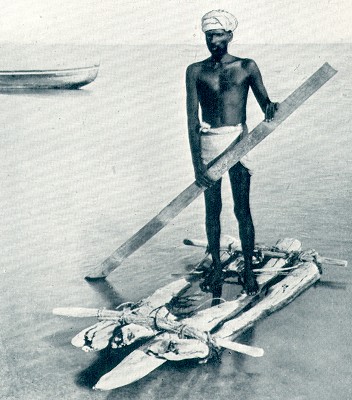 |
http://en.wikipedia.org/wiki/Catamarans
- viewed 27 October 2012.
3. Hornell: Water Transport (1946), page 261.
Full text at 1. above.
4. Bowrey, Thomas : A Geographical Account Of Countries Round The Bay Of Bengal, 1669 To 1679.
Edited by R.C. Temple.
Hakluyt Society, Cambridge, 1905.
http://archive.org/details/ageographicalac00bowrgoog
The image and the quotation are in Johnstone: The Sea-craft of Prehistory (1980), page 184.
Johnstone accredits both to A.H. Hill, 'Some Early Accounts of the Oriental Boat', Mariner's Mirror, vol 44, 1958, pp. 207-8.
"In the warm waters of the Indian Ocean, particularly on the eastern coast of the sub-continent, the continued and useful existence of the many forms of raft to this day recalls a situation that was probably much the same thousands of years ago.
As Bowrey said of his 'cattamaran' (Figure 13.17), 'they will boldly venture out of sight of the shore, but indeed they Swim me (in generall) as naturaly as Spanyall dogs.'(53)"

Figure 13.I
7: Bowrey's late seventeenth century drawing of an
Indian 'cattamaran' raft (Hill, MM, vol. 44,
1958, p. 209).
5. Dampier, William: A New Voyage Round the World.
James Knapton, London, 1698-1709, page 143
Goggle Books: Dampier
http://books.google.com.au
- viewed 10 October 2009.
"An 1684
Piura (northwestern Peru)
Single Bark Logs
The smaller sort of Bark-logs, described before, which lie flat on the Water, and are used for Fishing, or carrying Water to Ships, or the like (half a Tun or a Tun at a time) are more governable than the other, tho' they have Masts and Sails too.
With these they go out at night by the help of the Landwind (which is seldom wanting on this Coast) and return back in the day time with the Sea-wind.
This sort of Floats are used in many places both in the East and West-Indies.
On the Coast of Coromandel in the East-Indies they call them Catamarans.
These are but one Log, or two sometimes of a sort of light Wood, and are made without Sail or Rudder, and so small, that they carry but one Man, whose legs and breech are always in the Water, and he manages his Log with a Paddle, appearing at a distance like a Man sitting on a Fish's back."
6. British Library Online Gallery
http://www.bl.uk/onlinegallery/onlineex/apac/other/019jzz0000063c5u00000000.html
-viewed 27 October 2012.
"Water-colour drawing of a masula boat, Madras, dated c, 1787.
The drawing is inscribed: 'A Massula Boat, such as are used at Madras for crossing the Surf as no ship Boat can weather it'; in German: 'Ein boot Mosuli boot genannt, womit man' 'durch die brandung, durch die groszen Wellen geht, die hier zu sehen sind' (A boat, called a Masuli boat, with which people go through the surf and through the high waves, which you see here)."
7. Australian National Maritime Museum: Madrassan Men Surfing by Charles Gold.
http://emuseum.anmm.gov.au/code/emuseum.asp?id=19944
- viewed 25th October 2012.
8. Dela Vega, Timothy T., et al. : 200 Years of Surfing Literature - An Annoted Bibliography.
Published by Timothy T. Dela Vega.
Hanapepe, Kaui, Hawaii, 2004, page 18.
"Ellis, Rev. William 1794-1872
A-40 Polynesian Researches, During a Residence of Nearly Eighty Years in the Society and Sandwich Islands. Volumes I to IV. (London: Fisher, Son and Jackson., 1831) vol. IV, pp. 368-72.
This edition reproduces on its title page (See on pg.8) the first published drawing of a man standing on a surfboard, by F. Howard. "
9. "Surf boats at Madras - a pen and ink wash drawing in 1807 by Chinnery."
[Catamarran, paddles, fish traps and riders, foreground left.]
http://indiahistoryspeaks.blogspot.com.au/2007/12/british-and-tamil-jab-they-meet-fort-st.html
- viewed 25th October 2012.
This image is reproduced in The Malusa, footnote 13, above.
10. East, J.B.: "Catamarans and Masoolah Boat, Madras, c. 1834."
Watercolour.
Also known as "Madras, Embarking."
Coloured engraving by C. Hunt, 1856.
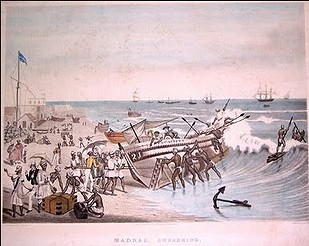
The original, with a companion painting, is held by the State Library of NSW.
http://acms.sl.nsw.gov.au/album/albumView.aspx?acmsID=423868&itemID=874482
- viewed 29 October 2012.
"Landing [waler] horses from Australia ;
Catamarans and Masoolah boat, Madras, c.1834 [Album view]
http://acms.sl.nsw.gov.au/album/albumView.aspx?acmsID=423868&itemID=874482
2 watercols. ; 15.2 x 24 cm.
Signatures / Inscriptions
"The small boats are catamarans, the large one is a Masoolah boat - a correct picture - the boats go through the surf exactly as depicted" -- inscribed in ink on reverse (1b)
General Note
Unsigned and undated
Titled from ink inscriptions on reverse sides of drawings
Attributed to the "Company School", possibly J.B. East (see notes on ML File 609/74 and Pxn 747)
Approximately dated from information about shipments of horses from NSW to Madras.
Source: Walers: a history of Australian horses abroad, 1834-1941 / Alexander Yarwood. Carlton, Vic: Melbourne University Press, 1989."
The image is online, without accreditation but with some notes, at:
Bharatasahitya
https://sites.google.com/site/bharatasahitya/images-from-centuries
"The image to the left is not a bad representation of what it was like to land at Fort Saint George from a masula boat, charging through the surf, which broke much more violently in the 1790s than it does now.
Those of you who are familiar with Chennai (as Madras is now called) will see that the beach is much larger, too, but the huge beach we see today is largely the result of sand deposits since the construction of the artificial harbor, which disrupted the currents along this part of the Coromandel Coast.
To the far left in this picture one can see the Master Attendant's flagstaff, which not only flew the Company's flag, but also signal flags used to communicate with the ships moored offshore.
These vessels are quite accurately depicted lingering about a mile and a half off shore, behind the third line of surf."
11. Standing surfboard riders adopt an off-set stance, with one foot forward and the other, the steering foot, towards the tail.
This is either with the right foot forward or "goofy", as in East's depiction, or with the left foot forward or "natural."
In the 20th century, the surfboard has branched into a variety of derivative "board sports," where the off-set stance predominates.
Examples include the skateboard, the sailboard, the snowboard, the wakeboard, and the kiteboard.
12. Design & Art Australia Online: John B. East
http://www.daao.org.au/bio/john-b-east/
- viewed 30 October 2012.
"John B. East
Also known as J. B. East, T. B. East, Mr E., J. B. Earl
Artist (Painter)
A portrait painter and miniaturist, J. B. East's best known work is his oil portrait of Jamaican boatman, Billy Blue.
His lively watercolours of Europeans and Indians reveal the human focus of his work and provide information about India where he lived, both before and after his period in Australia.
Residence
c.1836-c.1856 Madras, India
c.1831-c.1835 Sydney, NSW
c.1830-c.1831 India
c.1818-c.1830 England, UK"
13. East, J. B: "Billy Blue, 1834."
State Libray of NSW
http://acms.sl.nsw.gov.au/item/itemDetailPaged.aspx?itemID=404717
"Paintings : oil ; 63 x 50.2 cm
Biographical Note
William 'Billy' Blue was a Jamaican convict ferry master of some local fame because of his aphorisms and lively banter.
Governor Macquarie gave him a grant of land on the North Shore - now Blues Point
General Note
This portrait is probably the one mentioned in the Australian 9 May 1834.
It is also probably the one given to the Library in 1933 by a Mr. J.E. Blue, of North Sydney"
14. Sriram V: Madras Port – the result of determination & perseverance.
By XS Real, June 14, 2012
http://www.xsreal.com/blog/?p=196
- viewed 25th October 2012.
For full text see The Masula, footnote 9, above.
15. Hall ???
xx. Not Hall?
http://indiahistoryspeaks.blogspot.com.au/2007/12/british-and-tamil-jab-they-meet-fort-st.html
- viewed 25th October 2012.
[Unaccredited]: Letters to Madras (June-October 1834)
"At last a catamaran was discernible amidst the waves. Do you know what a catamaran is? It is simply a raft composed by tying two or three long pieces of wood together. On these rafts the fishermen of Madras venture on the sea in all weathers, in defiance of winds, waves, and sharks. The appearance of the little black boatman beating the water with his paddle, and seeming as familiar to the element as a duck, was the first glimpse that I caught of the people among whom I am to live. He came on board with nothing on him but a pointed yellow cap, and walked among us with a self-possession and civility which, coupled with his colour and his nakedness, nearly made me die of laughing."
16. The New Testament, The Acts of the Apostles, Chapter 27 Verses 41 to 44..
17. Champion (1814–1822), edited by John Scott.
London, January 27, 1822, page 11.
http://newspaperarchive.com/champion
- viewed 25 October 2012.
"THE LOSS OF THE LADY LUSHINGTON, INDIAMAN
The following melancholy details of the Lady Lushington were received from one of the surviving sufferers, and we submit it nearly in his own language:
"We sailed from Madras on the 5th, and having four passengers to land at Coringa, saw the light-house at midnight on the 7th: tacked about in hope of landing the four passengers abovementioned in the morning, but owing to the strong current we were considerably to leeward of the said port by daylight.
We endeavoured two days and a night to regain the windward, but finding we only lost ground, cast anchor on the northward of Coringa.
The surf ran very high for two days so we could have no communication with shore, so we tried to weigh anchor and drop down to Penticolla, but all endeavours were ineffectual when the cable parted and night had come on.
The Captain gave orders to stand out to sea until twelve o'clock at and then tack into the land; the chief mate took the command of the deck at and thinking we had sailed so far from the land that we could not possibly reach it before day-break; the ship tacked- a breeze having sprung we were alarmed by the ship striking slightly on the sand about four o'clock in the morning.
Nothing can paint the distressing scene; the high land was just visible and every wave driving over the ship added to our horrible situation.
In half an hour every mast was over the ship's side (to leeward); the ship drifted into a tremendous surf, every boat was staved in the attempt to lower them, and the land half a mile on our lee, we had nothing to trust to but the waves, and to place our confidence in the Almighty.
The scene of horror and distress then became indescribable.
The cries of the females and children were heart-rendering.
It was said that the bottom had parted from the upper works.
Every person was naked, and up to the middle in water, and the distress was increasing every moment.
Three spars of wood were got over the side, on which six persons, including myself, providentially reached the shore; but we were so much exhausted; that had not the natives come to our assistance, the return of the surf would have carried us out again; we found on the shore a sailor who had been washed over-board, to whom the safety of so many lives is owing: he fortunately spoke the language and succeeded in getting four catamarans from the shore to the assistance of the sufferers, a large boat was got off, but could get no nearer than one hundred yards, and with difficulty was kept above water.
At eleven the ship parted across the centre, and all the crew and passengers were obliged to get on the masts to have the ship as a breakwater, from which many were washed away being so fatigued as not to hold on.
The catamarans kept at work until two o'clock, when the wind increased so that they could not get near the wreck, and had afterwards to desist, finding it impossible to be of further use.
A Frenchman, his wife and two daughters, with two of the crew, were seen on the wreck: at four o'clock the stern parted; on which the French Lady with her eldest daughter reached shore; the father with the other daughter perished, as did the two sailors, one of whom was seen at dark sticking to the remains of the bows, which were held by the anchors.
The shore for six miles was strewed with the ship and cargo.
The number lost was 22, amongst we regret to were Capt. Hampton, 7th Madras Native Infanty, Ensign Wright, Mr. Wilson, formerly purser in the country service, Mr. Rosseau and his daughter, and Mr. Lester, second officer of the Lady Lushington.
The ship started in two at 11 a. m. and before evening scarce a vestige of her was visible.
Mrs. Rousseau, who was was on the stern, and her unfortunate husband was on the stem of the ship, when she parted.Major Weatherall and his lady are likewise and Mr. Carpenter only son of Colonel
The situation of the survivors is said to have been truly deplorable; all were nearly without clothes.
The Commander is acquitted of all blame.
- Indian Gazette."
- Champion (1814–1822), edited by John Scott, London, January 27, 1822, page 11.
http://newspaperarchive.com/champion
- viewed 25 October 2012.
Note: The ship was lost on 11 August 1821.
18. Colonies And India, London, October 4, 1879, page 11.
"Madras itself is not a particularly interesting place, yet there are many things worth seeing in that flat and level city; though we observe that the description of them does not occupy quite twenty pages of the Handbook.
As for our own impressions, we thought that the exciting work of landing through the surf-riding on the crest of a gigantic wave and then being swiftly whisked ashore by strong and swarthy arms was the best thing about Madras, except indeed the performance of the same operation when we took our departure.
How we envied the independence and pluck of the amphibious natives dancing over the dangerous surf on their tiny catamarans."
Newspaper Archive
Colonies And India, London, October 4, 1879, page 11.
http://newspaperarchive.com/colonies-and-india/1879-10-04/page-11/
(The Colonies and India was a London weekly journal containing the latest home, colonial and foreign intelligence.)
19. Hornell: Water Transport (1946), page 261. PLATE X, A.
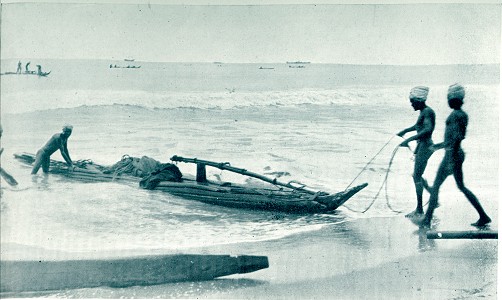
20. British Pathe: Shark Fishing - India, 1946.
http://www.britishpathe.com/video/shark-fishing-india/query/surfing
- viewed 26 October 2012.
"Thought to be Selected Originals from late 1940s material.
Shark fishing off the coast of Madras, India.
Various shots of the fishermen heading out to sea in their fragile catamarans. A shark is hauled aboard one of the craft. M/S of the boat riding the surf back to the shore. M/S..."
21. Modern catamarran, Chennai.
Shore landing.
Posted 26th December 2009 by Shantaram
http://chennaimadras.blogspot.com.au/2009/12/shore-landing.html
"The boat which Macaulay writes about would most likely have been the 'masula boat', but even in those times, catamarans (from 'kattu-maram', meaning 'logs tied together') such as the ones in the photo would have been very much in use."
22. Klein, H. Arthur: Surfing
J.B.Lippincott Company, Philadelphia and New York 1965, page 259.
